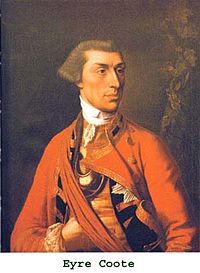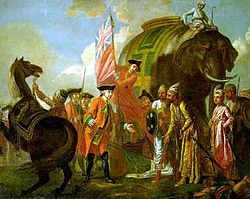- Eyre Coote (East India Company officer)
-
For his nephew, General Sir Eyre Coote, see Eyre Coote (British Army officer).
Lieutenant-General The Right Honourable
Sir Eyre Coote
KB
Nickname Coote the Brave Born 1726
Limerick, IrelandDied 1783
MadrasService/branch  British Army
British ArmyYears of service 1745–1783 Rank Lieutenant General Commands held 84th Regiment of Foot
Commander-in-Chief of IndiaBattles/wars Jacobite Rebellion
Second Carnatic War
Seven Years' War
Second Anglo-Mysore WarAwards Order of the Bath Other work Member of Parliament for Poole Lieutenant-General Sir Eyre Coote, KB (1726 – 28 April 1783) was an Irish soldier. He is best known for his many years of service with the British Army in India. His victory at the Battle of Wandiwash is considered a decisive turning point in the struggle for control in India between British and France. He was known by his sepoy troops as Coote Bahadur (Coote the Brave).[1]
Contents
Early life
The son of the Reverend Chidley Coote, he was born near Limerick, Ireland in 1726, and entered the 27th Regiment of Foot. He first saw active service in the Jacobite rising of 1745, and later obtained a captaincy in the 39th Regiment, the first regular British regiment sent to India.
Seven Years War
Further information: Great Britain in the Seven Years WarRecapture of Calcutta
Further information: Siege of CalcuttaIn 1756 a part of the regiment, then quartered at Madras, was sent forward to join Robert Clive in his operations against Calcutta which had recently been captured by captured by the forces of the Nawab of Bengal, which had been followed by the Black Hole of Calcutta. The city was reoccupied without difficulty in January 1757. However, Coote and Clive argued so violently over who should reoccupy Fort William that they almost fired at each other, which began a lifelong rivalry and hatred between the two men.[2]
Plassey
 Coote served under Clive at the Battle of Plassey in 1756 where he first distinguished himself.
Coote served under Clive at the Battle of Plassey in 1756 where he first distinguished himself. Main article: Battle of Plassey
Main article: Battle of PlasseyCoote was soon given the local rank of Major for his good conduct in surprising the camp of the Nawab of Bengal. Soon afterwards came the Battle of Plassey, which would probably never have taken place but for Coote's advice at the council of war; after the defeat of the Nawab he led a detachment in pursuit of the French for 400 miles under extraordinary difficulties. His conduct won him the rank of Lieutenant-Colonel and the command of the 84th Regiment of Foot, newly raised in Britain for Indian service, but his exertions had seriously damaged his health.
Wandiwash
Main article: Battle of WandiwashIn October 1759 Coote's regiment arrived to take part in the decisive struggle between French and British in the Carnatic. He took command of the forces at Madras, where a French siege had recently been defeated, and on 22 January 1760 led them in the decisive victory of Battle of Wandiwash.
After a time the remnants of Lally's forces were besieged in Pondicherry. For some reason Coote was not entrusted with the siege operations, but loyally supported William Monson, who brought the siege to a successful end on 15 January 1761. In the latter year he sat for Maryborough in the Irish House of Commons.
Soon afterwards Coote was given the command of the British East India Company's forces in Bengal, and settled of a serious dispute between the Nawab Mir Qasim and a powerful subordinate. In 1762 he returned to England, receiving a jewelled sword of honour from the Company and other rewards for his great services.In 1771 he was made a Knight of the Order of the Bath.
American War of Independence
Further information: Second Anglo-Mysore WarReturn to India
In 1779 he returned to India as Lieutenant-General commanding in chief. He allied himself to Warren Hastings, the Governer General who generally deferred to him and gave him a free hand over military matters, in opposition to Hasting's opponents on the ruling Council Edward Wheler and Philip Francis. He spent much of his time visiting outlying garrisons and chose to attend meetings of the Calcutta Council only when it was necessary to pass some important measure.[3] Without Coote's support, Hastings was likely to be outvoted on the Council.[4] This situation only ended when Francis returned home where he began to stir up criticism of Hastings' conduct with ultimately led to his failed impeachment.
Hyder attacks
Following Hyder Ali's opening of the Second Anglo-Mysore War in southern India Coote returned to active service. It was not until 1 June 1781 that Coote struck the first heavy blow against Hyder in the decisive Battle of Porto Novo. The battle was won by Coote against odds of five to one, and is regarded as one of the greatest feats of the British in India. It was followed up by another hard-fought battle at Pollilur (the scene of an earlier triumph of Hyder over a British force) on August 27, in which the British won another success, and by the rout of the Mysore troops at Sholinghur a month later. His last service was the arduous campaign of 1782, which finally shattered a constitution already gravely impaired by hardship and exertions. Coote died at Madras on 28 April 1783. The war with Mysore was brought to an inconclusive end by the Treaty of Mangalore in 1784. Subsequent conflicts fought, the Mysorean capital twice captured, and Hyder's dynasty eventually overthrown in 1799.
Legacy
Coote is generally remembered for his victory at Wandiwash and capture of Pondicherry which were decisive moments in the struggle between Britain and France for dominance in India.[5] Although he often quarrelled with other British officers and officials, Coote was adored by the sepoy troops under his command.[6] Following his death a monument was erected to him in Westminster Abbey and another within West Park, Rockbourne, Hampshire. His nephew was Sir Eyre Coote, GCB who served as Governor General of India .
He married in 1769 a daughter of Charles Hutchinson, Governor of St. Helena. They had no children, and his property, worth over £200,000, was left to his brother, Doctor Charles Coote, dean of Kilfenora, in County Clare, Ireland.[7] In his autobiography the American General and Secretary of State Colin Powell claims direct descent from Coote's identically named nephew Eyre Coote while he was serving as Governor of Jamaica, which has led to Powell sometimes being incorrectly referred to as a direct descendent of the elder General Coote.
Bibliography
- Harvey, Robert. Clive: The life and Death of a British Emperor. Hodder and Stoughton, 1998.
- Sheppard E. W. Coote Bahadur: A Life of Lieutenant-General Sir Eyre Coote, KB Werner Laurie 1956
- Turnbull, Patrick. Warren Hastings. New English Library, 1975.
References
 This article incorporates text from a publication now in the public domain: Chisholm, Hugh, ed (1911). Encyclopædia Britannica (11th ed.). Cambridge University Press.
This article incorporates text from a publication now in the public domain: Chisholm, Hugh, ed (1911). Encyclopædia Britannica (11th ed.). Cambridge University Press.External links
- Archival material relating to Eyre Coote (East India Company officer) listed at the UK National Register of Archives
Parliament of Ireland Preceded by
Warner Westenra
Bartholomew William GilbertMember of Parliament for Maryborough
1761
With: William GilbertSucceeded by
William Gilbert
John ParnellParliament of Great Britain Preceded by
Thomas Calcraft
Joshua MaugerMember of Parliament for Poole
1774–1780
With: Joshua MaugerSucceeded by
Joseph Gulston
William Morton PittMilitary offices Preceded by
John CarnacCommander-in-Chief, India
1761–1763Succeeded by
Thomas AdamsPreceded by
Giles StibbertCommander-in-Chief, India
1779–1783Succeeded by
Giles StibbertCategories:- 1726 births
- 1783 deaths
- 27th Regiment of Foot officers
- 39th Regiment of Foot officers
- 84th Regiment of Foot officers
- British Army generals
- British Army personnel of the Jacobite Rising of 1745
- British Commander-in-Chiefs of India
- British East India Company Army generals
- British MPs 1774–1780
- Irish MPs 1761–1768
- Knights Companion of the Order of the Bath
- Members of the Parliament of Great Britain for English constituencies
- Members of the Parliament of Ireland (pre-1801)
- People from County Limerick
- British Army personnel of the Seven Years' War
Wikimedia Foundation. 2010.
